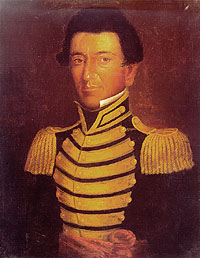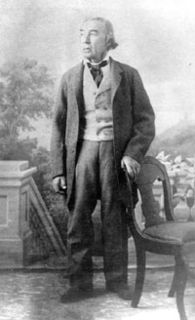
The Battle of the Alamo was a pivotal event in the Texas Revolution. Following a 13-day siege, Mexican troops under President General Antonio López de Santa Anna reclaimed the Alamo Mission near San Antonio de Béxar, killing the Texian and immigrant occupiers. Santa Anna's cruelty during the battle inspired many Texians, both legal Texas settlers and illegal immigrants from the United States, to join the Texian Army. Buoyed by a desire for revenge, the Texians defeated the Mexican Army at the Battle of San Jacinto, on April 21, 1836, ending the rebellion.

The Battle of Gonzales was the first military engagement of the Texas Revolution. It was fought near Gonzales, Texas, on October 2, 1835, between rebellious Texian settlers and a detachment of Mexican army soldiers.

Juan Nepomuceno Seguín was a Tejano political and military figure of the Texas Revolution who helped to establish the independence of Texas and signed its declaration of independence. Numerous places and institutions are named in his honor, including the county seat of Seguin in Guadalupe County, the Juan N. Seguin Memorial Interchange in Houston, Juan Seguin Monument in Seguin, World War II Liberty Ship SS Juan N. Seguin, Seguin High School in Arlington.

José Antonio Navarro was a Texas statesman, revolutionary, rancher, and merchant. The son of Ángel Navarro and Josefa María Ruiz y Peña, he was born into a distinguished noble family at San Antonio de Béxar in the Viceroyalty of New Spain. His uncle was José Francisco Ruiz and his brother-in-law was Juan Martín de Veramendi.
James Clinton Neill was a 19th-century American soldier and politician, most noted for his role in the Texas Revolution and the early defense of the Alamo. He was born in North Carolina.

Susanna Wilkerson Dickinson and her infant daughter, Angelina, were among the few American survivors of 1836 Battle of the Alamo during the Texas Revolution. Her husband, Almaron Dickinson, and 185 other Texian defenders were killed by the Mexican Army.
Philip Dimmitt (1801–1841) was an officer in the Texian Army during the Texas Revolution. Born in Kentucky, Dimmitt moved to Texas in 1823 and soon operated a series of trading posts. After learning that Mexican General Martín Perfecto de Cos was en route to Texas in the year 1835 (??) to quell the unrest, Dimmitt proposed that the general be kidnapped on his arrival at Copano. The plan was shelved when fighting broke out at Gonzales, but by early October, 1835, it had been resuscitated by a group of volunteers at Matamoros. Not knowing that Cos had already departed for San Antonio de Bexar, this group decided to corner Cos at Presidio La Bahia in Goliad. Dimmitt joined them en route, and participated in the battle of Goliad.

The Battle of the Alamo left a substantial legacy and influence within American culture and is an event that is told from the perspective of the vanquished.
Salvador Flores served as a volunteer in the Texan Army in 1835–1836. He was instrumental in organizing and commanding Texian volunteers in support of the Texas Revolution. He participated in many battles and would rise through the ranks to reach Captain status during the fight for Texas independence from Mexico. Salvador continued to provide protection for the ranches and settlers of Texas throughout the Republic years.

Manuel Flores served as a volunteer in the Texas army in 1835–1838. Fighting and commanding, he rose through the ranks to reach sergeant status during the fight for Texas independence and was commissioned a captain during the Republic years.
José Gregorio Esparza, also known as Gregorio Esparza, was the last Texan defender to enter the Alamo during the early days of March 1836 in the Siege of the Alamo and was the only one that was not burned in the pyres. He had brought his family into the Alamo compound along with him. They were able to survive the battle and were not executed by the conquering army.

José Toribio Losoya, was a former Mexican soldier, a Texian military participant in the Siege of Bexar and Battle of the Alamo defender.
William Ward, was a Macon, Georgia native, who answered the appeal from Texas, during the Texas Revolution. He recruited men from Georgia and led the Georgia Battalion.
Francisco de Castañeda, also spelled Castonado, was a lieutenant in the Mexican army stationed in San Antonio, in the 1830s. He was the commander of the troops involved in the first battle of the Texas Revolution.
Andrew Jackson Sowell was a lifelong soldier and farmer in the 19th century. He was a participant in the Texas Revolution and a survivor of the siege of the Alamo. He continued his service during the years of the Republic of Texas, in the Mexican–American War, and the Civil War. He was a frontier defender, early Texas Ranger, and a friend and scout with Kit Carson.
Juan Valentín Amador (1793–1848) was a general in the Mexican army of the 19th century. He served under Mexican President Antonio López de Santa Anna during the Texas revolution.










